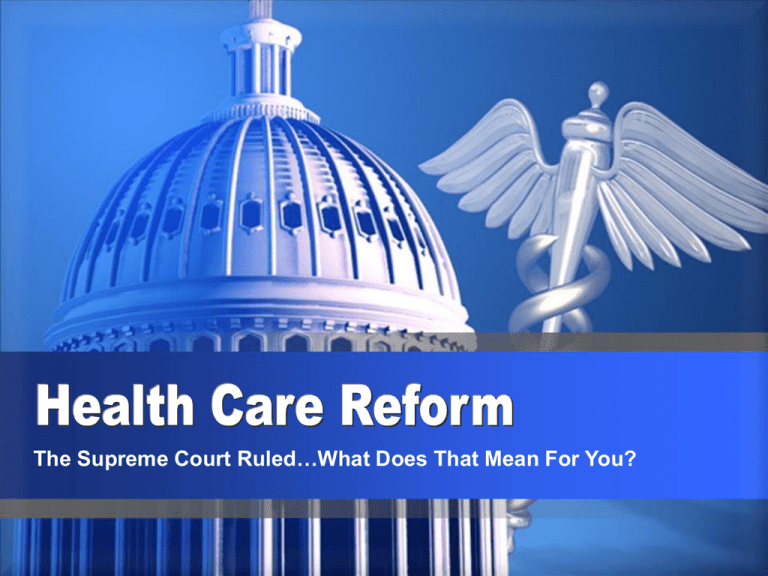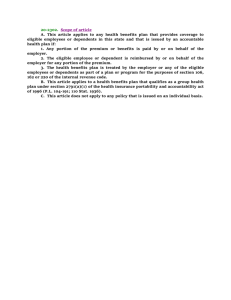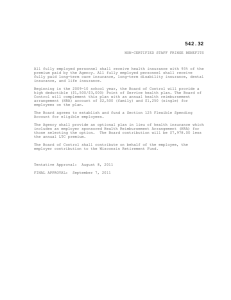Health Care Reform - Florida Insurance Brokers
advertisement

The Supreme Court Ruled…What Does That Mean For You? Agenda • The Supreme Court’s Ruling on Health Care Reform • Employer Implications: Focus on Compliance Timetable • The Elections & Health Care Reform • Employer Next Steps: What Employers can do now The Supreme Court Ruling The “Individual Mandate” All adults must buy health insurance or pay a tax penalty starting in 2014. • Tax Penalty up to 2.5% of taxable income (or $2,085 for families), whichever is greater. • Said to be essential because of the ban on pre-existing conditions exclusions (guaranteed issue) and community rating. • Risk management • 26 states were joined in the lawsuit to overturn the individual mandate. verses Large Risk Pool instead of underwriting. The Central Question Does the Constitution give Congress the power to require American Citizens to purchase a product or service? The Supreme Court’s Answer… “The Federal Government does not have the power to order people to buy health insurance. However, the Federal Government does have the power to impose a tax on those without health insurance.” (Similar to a child tax credit) NFIB, et al., v, Sebelius, Chief Justice John Roberts Majority Opinion, p. 44 PPACA is Moving Forward Patient Protection & Affordable Care Act The Patient Protection & Affordable Care Act’s (PPACA) individual mandate is constitutional under the taxing power of congress. Every provision in the law is upheld except the remedy on states that do not expand Medicaid eligibility to 133% of the federal poverty level. Example: $14,000 x 133% = $18,620 $8.95 Per Hour / 40 Hours Per Week In The News In the News In the News Employer Implications PPACA - Currently in Effect Patient Protection & Affordable Care Act 2010 • No Pre Existing Conditions – Dependent Children covered up to age 19 • Expanded Wellness Benefits – Covered 100%, No copays or deductibles • Emergency Benefits – Covered the same, In or Out of Network • Unlimited Lifetime Maximum Benefits • Adult Dependent Children: Small Group – Can remain on plan until age 30 Large Group – Can remain on plan until age 26 • PCIP (Pre Existing Insurance Plan) – Offered to individuals with pre-existing conditions who have been without coverage for at least 6 months. • Small Employer Tax Credit of 35% • No more than 25 Full Time Employees, Wages must be less than $50K per year • Grandfathered Plans • Over The Counter Drugs (OTC) – Exclusions on HSA, FSA & HRA Plans PPACA - Currently in Effect Patient Protection & Affordable Care Act 2012 MLR (Medical Loss Ratio) The Affordable Care Act requires health insurance issuers to submit data on the proportion of premium revenues spent on clinical services and quality improvement, also known as the Medical Loss Ratio (MLR). It also requires them to issue rebates to enrollees if this percentage does not meet minimum standards. MLR requires insurance companies to spend at least 80% or 85% of premium dollars on medical care, with the review provisions imposing tighter limits on health insurance rate increases. If they fail to meet these standards, the insurance companies will be required to provide a rebate to their customers starting in 2012. 80/20 – Small Group 85/15 – Large Group Rebate Checks: Have been issued as of August 1, 2012. Employers have 90 days to distribute funds to their employees. EMR (Electronic Medical Records) Medical Providers will be receiving grant money to purchase hardware and software to improve efficiency and accuracy as well as meet the most up to date standards of EMR requirements. Compliance Timetable 2012 – 2013 2014 and Beyond • • • • • • Employer “Play or Pay” • Individual Mandate • State Exchanges Summary of Benefits & Coverage (2012) W-2 Reporting FSA Contribution Cap Increased Medicare Tax State Exchange Notices • Premium subsidies explode • PACCA Budget deficit $1.4 Trillion (2021) Avg. Family Contribution $26k • 40% Excise Tax on Cadillac Plans (2018) Provide Summary of Benefits & Coverage Employers must provide employees with a standard “Summary of Benefits and Coverage” (SBC), effective for plan years and open enrollments, beginning 9/23/12. *Most will be provided by the Insurance Carriers Required Content: In 12 Point Font – Maximum of 6 pages • Description of coverage including cost-sharing requirements (deductibles & copays) • Information on coverage exceptions, reductions or limitations. • Renewability and continuations of coverage provisions. • Contact information for questions. • Information for obtaining a list of network providers. • Information on prescription drug coverage. • Uniform glossary. • Linguistically Appropriate www.dol.gov/ebsa Glossary of Health Insurance Terms Allowed Amount: This is the dollar amount typically considered “payment in full” by the insurance company. For example, the total charge for a visit comes to $100. If the doctor is a member of your health insurance company's network of providers, they may be required to accept $80 as payment in full for the visit - this is the Allowable Charge. This may be called “eligible expense,” “payment allowance” or “negotiated rate.” If your provider charges more than the allowed amount, you may have to pay the difference. (see Balance Billing) Balance Billing: When a provider bills you for the difference between the provider’s charge and the allowed amount. For example, if the provider’s charge is $100 and the allowed amount is $80, the provider may bill you for the remaining $20. A preferred provider may prevent this from happening. Co-Insurance: A percentage that you pay after the deductible is exceeded. Your health insurance pays the rest of the allowed amount. Premium: The total amount paid to the insurance company for health insurance coverage. This is typically a monthly charge. Qualifying Event: An event such as a termination, divorce, birth or adoption, change in employment status or death of spouse or other dependent. Co-Payment: A fixed amount (for example, $15) for a covered service, usually paid by the insured at the time of service. The amount can vary depending on the type of service provided. Deductible: A specific dollar amount that your health insurance company may require you to pay out of pocket each year before your health insurance begins to make payments for claims. Typically HMO plans do not require a deductible, while most Indemnity and PPO Plans do. Durable Medical Equipment (DME): Equipment and supplies ordered by a health care provider for everyday or extended use. Coverage for DME may include; oxygen equipment, wheelchairs, crutches or blood testing supplies. Emergency Medical Condition: Any illness, injury, symptom or condition so serious that a reasonable person would seek care right away to avoid serious bodily harm. Emergency Medical Transportation: Transportation to a hospital by ambulance for emergency medical conditions. Health Insurance: A contract that requires your health insurer to pay some or all of your health care costs in exchange for a premium. Glossary of Health Insurance Terms In Patient Hospitalization: Care in a hospital that requires admission as a patient, which results in an overnight stay. Outpatient Care: Care in a hospital that usually does not require an overnight stay. Maximum Out-of-Pocket Costs: An annual cap on all cost sharing for which patients are responsible under a health insurance plan. This limit does not apply to premiums, balance billed charges from out of network health providers or services that are not covered by the health plan. Medically Necessary: Health care services or supplies needed to prevent, diagnose or treat an illness, injury, disease or its symptoms and that meet the accepted standards of medicine. Network: A group of Providers and Suppliers that your health insurance provider has contracted with to provide health care services. In Network Provider: A health care provider who has a contractual relationship with a health insurance company. Among other things, this contractual relationship may establish standards of care, clinical protocols, and allowable charges for specific services. Physician Services: Health care services a licensed medical physician provides or coordinates. Lab/X-Ray: Typically, lab and x-ray is any diagnostic lab test or diagnostic/therapeutic x-ray in support of basic health services. Lab services typically include, blood panels and urinalysis. Xray services include basic outpatient skeletal or ultrasound films, MRI and CT scans. Out-of Pocket Limit: The most you will pay annualy before your health insurance or begins to pay 100% of the allowed amount. This limit never includes your premium, balance-billed charges or services your health insurance does not cover. Some health insurance plans do not count all of your copays, deductibles, coinsurance, out of network payments or other expenses toward this limit. Non-Preferred Provider: A provider who does not have a contract with your health insurance company. Typically you will pay more to see a non network provider. Specialist: A doctor who does not service as a primary care physician, but who does provide secondary care specializing in a specific medical field. Glossary of Health Insurance Terms Rehabilitation Services: Health care services that help a person keep, get back or improve skill and functioning for daily living that have been lost or impaired because a person was sick, hurt or disabled. These services may include physical and occupational therapy, speech pathology and psychiatric rehabilitation services in a variety or inpatient and outpatient settings. Skilled Nursing Care: Services rendered by or under the supervision of a Registered Nurse in your own home or in a nursing home. Skilled nursing care may include the administration of medications, tube feeding, the changing of wound dressings, and some types of minor surgery. UCR (Usual, Customary & Reasonable): This refers to the standard or most common charge for a particular medical service when rendered in a particular geographic area. Urgent Care: Care for an illness, injury or condition serious enough that a reasonable person would seek care right away, but not so severe as to require emergency room care. Preauthorization: A decision by your health insurer that a particular medical service, treatment plan, prescription drug or durable medical equipment is necessary. Sometimes called prior authorization, prior approval or precertification. Premium: The total amount paid to the insurance company for health insurance coverage. This is typically a monthly charge. The premium is paid in whole or in part by the employer on behalf of the employee and their dependents. Primary Care Physician: Basic health care services, generally rendered by those who practice family medicine, pediatrics or internal medicine. Report Health Care on Form W-2 Starting January 1, 2013 Employers must report the "value” (i.e., cost) of employer sponsored coverage. No Tax Consequences: “Information Reporting” to improve transparency. Future Tax Implications: “Cadillac Tax” & other limits on present law exclusion. IRS Guidance: Report in box 12, Code DD the “aggregate cost” of all “applicable employer provided coverage” i.e. coverage excludible form the employee’s gross income. (March 29,2011), Notice 2011-28 Interim guidance on informational reporting to employees of the cost of their group health insurance coverage. (Jan. 23,2012, Notice 2012-9) Cap on FSA Contributions PPACA Imposes a $2,500 cap (indexed for inflation) on salary reduction FSA contributions for “taxable years” beginning after December 31, 2012. May 30, 2012, IRS Notice 2012-40: • Transition relief for non calendar year plans: Does not apply to plan years that begin before 2013. (e.g., Oct. 1 plan year cap effective October 1, 2013) • May adopt amendments anytime before the end of 2014. • Applies only to employee contributions, on employee by employee basis. The IRS also requests comments on changes to the FSA “use it or lose it” rule. New rules on HSA Over the Counter Rx & 20% tax. Increase Withholding for Medicare Tax For taxable years beginning after Dec. 31, 2012, Medicare taxes will increase 0.9% (from 1.4% to 2.35%) for employee wages in excess of $200,000 per year. • Intended to help finance premium subsidies for the uninsured. • All wages currently subject to Medicare tax are subject to the increase. • Employer is required to withhold additional tax on total wages, including noncash fringe benefits. • Begin withholding once an employee’s wages are over the threshold. • No employer match – Employer tax rate remains 1.45%. • Expect revised Form 941 but same Form W-2, box 6. • Seek additional guidance from your legal or tax professional. Notify Employees of State Exchanges No later than March 1, 2013, employers must provide employees with written notice of: • Health Insurance exchange availability in the state. • Potential eligibility for tax credits. • Possible loss of employer contribution (if any) if employee elects exchange coverage. • For low wage employees to receive a subsidy they must purchase their coverage through an exchange. “Play or Pay” for Employee Coverage Starting in 2014, Employers with 51+ employees face penalties, if no coverage is offered to full-time employees (30 hr per wk), or coverage offered is either “unaffordable” or “not comprehensive”. $2,000 per EE / per Year No Coverage Minimum Essential Coverage $166.67 per EE / per Month Costs > 9.5% of EE’s Wages, or $3,000 per EE that receives subsidies for exchange coverage. (Employees & Dependents) Covers < 60% Of Allowed Costs $250 per EE / per Month Play or Pay Details • Only applies to full-time employees. 30 Hrs Per wk • Current tests for “minimum essential coverage”. Is Coverage Affordable? “Employee’s Required Contribution”, or premium share, for self-only coverage on the employer’s lowest cost plan must not exceed 9.5% of employee income i.e., box 1 W-2 wages. Is coverage comprehensive? “Actuarial value of benefits,” or the plan’s share of total allowed costs, must be at least 60% of costs, i.e. plan reimburses covered costs at the rate of 60¢ on the dollar. State Health Insurance Exchanges Beginning January 1, 2014, states must establish an “American Health Benefit Exchange” and small business (SHOP) exchange. Details: • • • Pooled risk to offer individuals “group” rates. Only offer qualified health plans Platinum/Gold/Silver/Bronze Federal government to subsidize premiums up to 400% of poverty level, $70,000. Different exchange concepts: • Utah Model: A virtual “Travelocity” marketplace for all plans & consumers. Massachusetts: State control health plan Vermont: “Single Payer” • Private Exchanges – Aetna/BCBS/UHC Challenges: • • • • • Individual & Employer Play or Pay mandates depend upon exchanges. Will differ from state to state. States’ budget problems, including unfunded pension liabilities, may cause delay in implementation. Federal layouts for premium subsidies could explode ($1.4 Trillion through 2021) Play or Pay, compliance mandates in exchanges could lead to employer sponsored benefits redesigns. Definition of “essential health benefits” will drive premium costs. The Election & Health Care Reform SCOTUS, Elections & Legislation Supreme Court of the United States The Supreme Court decision could build momentum for 2013 legislation to “repeal and replace” PPACA. • Medicaid expansion and United States Government subsidies could cost $2 Trillion over 10 years. • Congressional Budget Office estimates that the individual mandate could force 4 million people to pay an average penalty of $1,000 in 2016. • Individual mandate as a “tax increases” could be a opening for new legislation to scale back subsidies. • The Real verdict on PPACA will come in the November Elections. The End? March 23, 2010, was only the beginning, not the end; Health Care Reform will be an ongoing legislative process. Next Steps What Employers Should Do Now? The Supreme Courts decision is important; legislation is possible, but employer focus must be on compliance! 1. Recognize that PPACA litigation is at an end it’s the LAW 2. Focus on existing laws and regulations 3. Develop & Implement a Compliance Plan Be in compliance with 2010-2013 provisions Gear up for 2014 – Play or Pay - What is a full-time employee? (avg. 30 hours per week) - Does our coverage meet the affordability standard? - Does our coverage meet the minimum value standard? - Is your state’s insurance exchange up and running? Questions & Answers www.HHS.gov www.dol.gov/ebsa www.pcip.gov www.healthcare.gov www.allhealth.org








